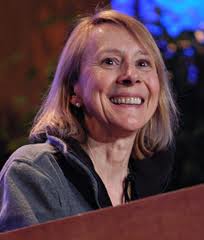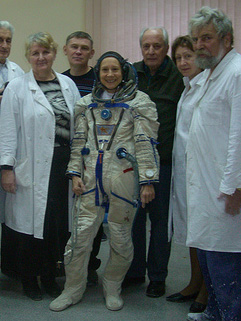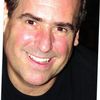
Esther Dyson (Twitter: @edyson) is a most fascinating lady. She's a noted former journalist; a captivated Internet scholar; an acclaimed angel; a passionate philanthropist; an inveterate technology investor in more than 40 companies; a hardened board member of more than 10 companies; and one heckuva good person with whom to talk technology. She's plugged in.
Named by Forbes as "one of America's most powerful women in business," Esther's thinking operates on multiple levels and verticals continuously.
And like the Energizer Bunny or an American president, she never stops going and is always traveling.
Esther was born in Switzerland and grew up in a truly intellectual, well-travelled family. The daughter of a father physicist and mother mathematician, Esther inherited some serious grey matter and her natural curiosity about how things worked took her from there. Her father worked at the Institute for Advanced Study at Princeton (where Einstein was one of the first faculty members from 1933 to his death in 1955) and Esther grew up with Nobel Prize winners hanging out in her home.
I caught up with her recently in Greenwich Village for a wide-ranging, free-associating free-for-all type conversation. As I walked into the MeetUp offices for our chat (Esther sits on their board), I thought I was caught in a time-warp; there was nobody visibly older that 18, I thought. Out came Esther looking just as at home with these youngster neophytes as she could be.

Esther Dyson
Esther being the kind of person she is -- talkative, in a good way -- I wanted her to focus on three topics. She chose "Health & Behavior," "Space Travel" and of course, "Russia." (Esther is a well-known Russophile.)
On "Health & Behavior"
"I've been more or less a vegetarian for 20 years," Esther started off directly; apparently we were going right into the Health part of the conversation. "No fried stuff or potato chips," she warned sternly, "I also avoid cookies, cigarettes, hot dogs -- hot dogs especially -- no fats. The challenge for people is to change our behaviors."
Esther segments what she calls the "Health & Behavior" industry into three distinct and separate markets: Healthcare; Bad Health; and Health.
About Healthcare she says, "This is the one I'm least interested in because it involves drugs, hospitals, clinics, medical supplies and so on. This is not the area where I invest or am able to bring a lot of forward movement."
On Bad Health, "This is where we can all change the way we eat and our behaviors. Avoiding foods that are so bad for us, and exercising regularly."
The Health segment is where Esther really shines, not that she was drab prior to that. "This is a very exciting market to me," she begins, "it's where we have Nike making the latest sports equipment and health clubs abounding. It's where we have all the high-tech tools. Companies like Health Gauge, HealthEngage and Fitbit, whose product monitors everything we do -- eat, walk, sleep -- are going to save lives and improve health. They provide the tools we need. Imagine driving your car with no speedometer or gas gauge. So I know for instance, that I've walked 8484 steps so far today," she said glancing at her gadget.
"Devices like Fitbit's monitor my blood pressure, pulse and all the other important biological metrics," Esther said, "and this is what excites me, early adopters of health technologies like this read about and then seek out these new tools. Employees are starting to notice corporate-wellness companies like Keas who get their employers onboard with better health for all. Corporations are more and more concerned with the costs of bad health such as absenteeism, productivity decline and depression amongst their people. The insurance companies don't care about anything but the direct costs of treatment; and the providers get paid for your bad health. But the good news is," according to Esther, "over time, the vision is that all these early adopters will be generating data and that data will be analyzed for the greater good."
Esther also is invested in or sits on the boards of 23 & Me (the CEO is Anne Wojcicki also known as Mrs. Sergey Brin); Genomera; and Keas ... some pretty cutting-edge companies with big visions.
Now there are two things you need to know about Esther. Number one is that she's into taking pictures everywhere she goes and that's all over the world. She was one of the early investors in online photo site success, Flickr (sold to Yahoo!), so that gives you some idea of her fascination.
The second thing you need to know about Esther is she swims everywhere she goes, like in swimming pools. She swears by them and thinks they saved her life. "I've been swimming every single day of my life since I was 18," she beams. That's why she's got a set in Flickr with 494 pools she's swum in globally; it's off-the-charts.
At this point, Esther shifts gears into her latest area of exploration.
On "Space Travel"
From October of 2008 to March of 2009, Esther was training to go into space. The way I wrote that previous sentence sounds like an entry on somebody's resume: "Esther spent her summer in Beijing learning Chinese," only the woman was training to go into space, like an astronaut.
Up until that moment I had never wanted to be anybody else, but right then, I wanted to be Esther Dyson in a big way.

Esther in a spacesuit
Arranged by Space Adventures of Arlington, Virginia, which bills itself as "the only company to have sent private citizens into space," these experiences have got to be one of the most sought-after and savored activities of the super-rich. Many billionaires haven't done this yet; but Esther has done everything in terms of training, she just didn't go up yet. I wouldn't bet against her in the long run though.
Esther was acting as a back-up (stand-in? understudy?) for Charles Simonyi, whose certifiably genius software engineering talents only include being the real software brain behind Microsoft and the "Father of Office," as well as becoming the "fifth space tourist" and second Hungarian in space in 2007. Simonyi wanted to go up yet again for an affordably priced $40 million. What was the cost for Esther to simply train to go up? A pittance: $3 million.
Going through the training with Simonyi and Martha Stewart, Esther excelled and finished much faster than mere Amerikanskis as she had the advantage of speaking Russian fluently.
Based at the "Yuri Gargarin Cosmonaut Training Center" outside of Moscow, Esther soaked up all she could in terms of technology and physics; this training appeared to have been a genuine coup for her.
Though the launch site is based in Kazakhstan, Esther received a complete training program that any cosmonaut would so that in the event of some change in Simonyi's situation, Esther would be ready to go at a moment's notice. The preparations included operational, physical and space training including zero-gravity.

'Zero-G Esther'
From what Esther told me, this appears to have been a once-in-a-lifetime opportunity for her to experience something most of us can never, ever hope to experience.
On "Russia"
If it was possible for Esther to get any more excited or animated about topics other than Health and Space Travel, it is only the topic of Russia that would take her to a higher level.
"I learned Russian when I was 14 or 15," Esther began, "I already spoke French and German so I had an affinity for different languages and I had wanted to be a foreign correspondent in Russia." Going to Russia for the first time in 1989, Esther was charmed by all the little "co-ops" dotting Russia. "I learned so much about the U.S. from going to Russia." Esther recalled, "I finally understood all the things I took for granted about America," she emphasized.
With regard to Russian and American business methods, Esther observes, "Both in the U.S. and Russia, people overvalue ideas and undervalue execution." Esther is qualified to notice as she sits on the boards of Russian goliaths IBS and Yandex.
Asked to comment on Skolkovo, the Russian government's attempt to partner with private enterprise and academia to fabricate a big technology incubator and build a university along the lines of a Harvard or Wharton outside Moscow, Esther says, "I don't think they should build it but instead allow it to grow around already existing universities." Esther's right about this; the last thing the Russian government should be doing with its copious oil and gas revenues is building another university from scratch when it already has many that house many of the most brilliant minds in the world.
"It's complicated," she says, "the Russians really need to fix Russia. One of the ways that can help immensely is through philanthropy. The challenge in Russia is that there was very little private philanthropy. But that's starting to change with Dmitry Zimin and his Dynasty Foundation," she brightens considerably. Using the significant fortune he acquired while building one of Russia's biggest telecoms, Vimpelcom, Zimin has provided a great role model for other wealthy Russian industrialists.
"Another charity in Russia I think is great is Maria's Children; they're developing a great interest in philanthropies in Russia," Esther concluded.
As I finished up and packed my briefcase thinking Esther was done with me, she asked if I wanted to come to a special, invitation-only preview of a film on the early Silicon Valley venture capitalists. Flattered, I thought "why not?"
One never knows what's next with Esther Dyson.
